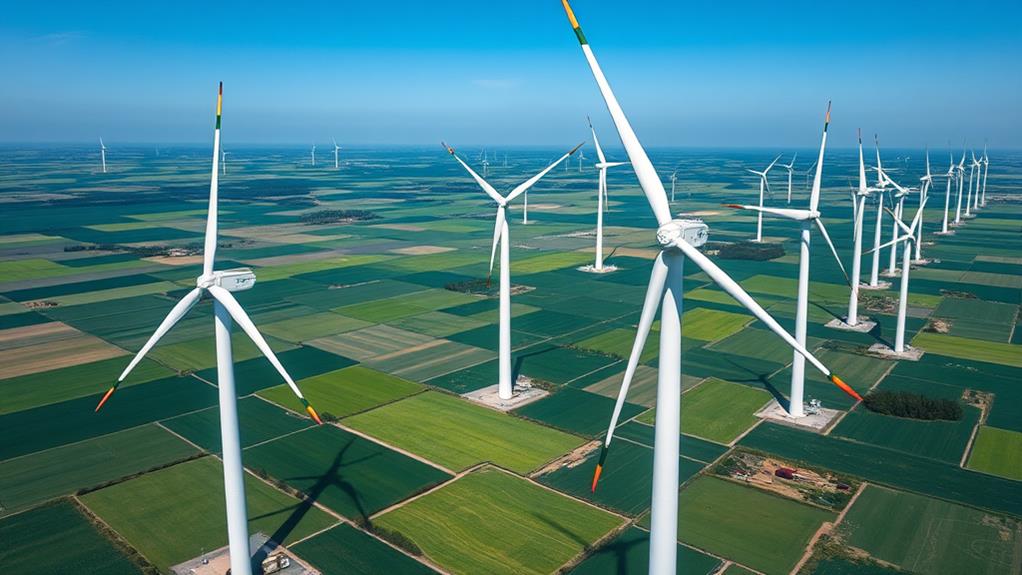Repowering aging wind farms is essential for maximizing energy efficiency, enhancing economic benefits, and minimizing environmental impact. As we see, existing turbines often operate below capacity due to technological obsolescence, with potential energy production increases of 30-50% achievable through modern turbine upgrades. Replacing outdated models can also greatly reduce operational costs and maintenance needs while promoting local job creation. Additionally, modern turbines feature quieter operations and improved ecological designs, offering a smaller footprint. Overcoming regulatory hurdles and community engagement are vital for successful projects. By understanding these dynamics, we can better appreciate the broader implications of repowering initiatives.
Key Takeaways
- Repowering aging wind farms can boost energy production by 30-50%, optimizing existing infrastructure and enhancing overall efficiency.
- Modern turbines reduce operational costs and environmental impact, leading to significant long-term economic benefits.
- Repowering minimizes the number of turbines needed, decreasing land clearing and ecological footprint while leveraging existing grid connections.
- Community engagement is essential for successful repowering, addressing concerns about noise, visual impact, and regulatory challenges.
- Repowering projects create local jobs, stimulate economic growth, and promote sustainable energy initiatives within communities.



Current State of Wind Farms
As we look at the current state of wind farms in Australia, it’s clear that many are nearing 15 years of operation, with some even exceeding 20-30 years. These existing wind farms, while providing favorable wind conditions, rely on older turbines that may not fully capitalize on the advancements in newer technology. Despite their established infrastructure and community acceptance, no Australian wind farm has undergone repowering to date, indicating a significant opportunity for modernization. Repowering can potentially enhance energy production by 30-50%, extending the operational life of these facilities. By leveraging existing grid connections, we can facilitate the expansion of Renewable Energy Zones, ultimately enabling a shift to more efficient energy production and promoting sustainability in our energy landscape.
Understanding Wind Farm Repowering

Understanding wind farm repowering requires us to contemplate both the definition and the intricate process involved, which typically entails upgrading or replacing aging turbines with advanced technology, ultimately enhancing energy output and efficiency. By leveraging existing sites, we can achieve significant economic and environmental benefits, such as increasing energy production capacity by up to 50% while minimizing the number of turbines needed. As we explore this topic further, it is vital to address the technical specifications of modern turbines, the potential for reduced operational costs, and the importance of community engagement in maneuvering regulatory challenges.
Definition and Process
Repowering aging wind farms involves a strategic overhaul of older turbines by replacing them with modern, more efficient models. This process may include partial upgrades of existing wind turbines or complete replacements, utilizing advanced technology that features larger towers and longer rotor blades. By maximizing energy output, we can achieve production increases of 30-50% compared to older installations. The benefits of repowering extend beyond mere efficiency, as these upgrades enhance the operational reliability of wind farms, thereby contributing to our sustainability goals and reducing fossil fuel dependency. Additionally, existing sites benefit from established infrastructure and community acceptance, making them prime candidates for repowering initiatives, while careful environmental considerations guarantee we maintain harmony with our surroundings throughout the process.






Economic and Environmental Benefits
By investing in the repowering of aging wind farms, we can release substantial economic and environmental benefits that support both energy efficiency and sustainability. By replacing older turbines with newer turbines, we can boost energy production by 30-50%, optimizing output from existing transmission infrastructure. This upgrade not only enhances production but also reduces operational costs, leading to considerable long-term economic benefits through lowered maintenance and energy expenses. Additionally, modern turbines are quieter and have a smaller ecological footprint, minimizing their impact on local wildlife and fostering community acceptance. Repowering further aligns with global renewable energy targets, greatly contributing to the reduction of carbon emissions, thereby supporting our collective goal of achieving net-zero emissions in various regions.
Advantages of Repowering

As we consider the advantages of repowering aging wind farms, we find that the replacement of outdated turbines with modern models can greatly enhance energy efficiency, often increasing production by 30-50%. By utilizing advanced technology that can triple the output of older turbines, we not only maximize our renewable energy potential but also reduce operational costs, ultimately leading to lower maintenance expenses. Additionally, this shift allows us to minimize the environmental impact by decreasing the number of turbines required, while also fostering greater community acceptance through the deployment of quieter, more aesthetically pleasing designs.
Increased Energy Efficiency
Over the years, the benefits of repowering aging wind farms have become increasingly clear, particularly when it comes to energy efficiency. By replacing older turbines with modern turbines, we can achieve an impressive increase in energy production—up to 30-50%. These newer turbines feature larger rotor diameters and higher hub heights, allowing them to capture more energy even at lower wind speeds, thereby enhancing overall performance and reliability. The advancements in turbine technology are evident, with average nameplate capacities rising from 1.6 MW in 2006 to 3.0 MW in 2021. Full repowering can potentially triple a wind farm’s energy output, optimizing land use and reducing operational costs, ultimately leading to improved grid stability and greater economic benefits for all stakeholders involved.
Reduced Environmental Impact
In recent years, we’ve seen that repowering aging wind farms not only boosts energy production but also considerably reduces environmental impact. By replacing older turbines with modern models, we can decrease the number of turbines needed, minimizing land clearing and environmental disruption by 30-50%. These advanced technologies are designed for enhanced energy efficiency, producing less noise and a smaller ecological footprint. Additionally, upgrading existing sites allows us to leverage established grid connections, reducing the need for new infrastructure. The operational data gathered over the years also aids in understanding wildlife interactions, which helps mitigate adverse effects on local ecosystems. Ultimately, repowering contributes to lower carbon emissions, aligning with our broader climate goals while safeguarding our planet.
Key Considerations for Repowering

Repowering aging wind farms involves several key considerations that can determine the success of such initiatives. Primarily, repowering involves upgrading existing wind energy projects by replacing older turbines with newer, more efficient models, potentially increasing energy production by 30-50%. However, we must navigate regulatory hurdles and permitting complexities, which often require extensive community consultation and environmental assessments. Additionally, addressing logistical challenges is essential, as decommissioning older turbines and enhancing energy infrastructure necessitates careful planning to minimize disruptions. The importance of community acceptance cannot be overstated, as local stakeholders may express concerns about noise, visual impact, and wildlife interactions related to new installations. Ultimately, a strategic and collaborative approach will pave the way for successful repowering projects.
Environmental and Social Impacts

As we consider the implications of repowering aging wind farms, it is crucial to address the environmental and social impacts that come with these projects. The benefits of modernizing existing sites are significant, particularly in enhancing energy production while preserving local ecosystems. Key considerations include:
- Wildlife Interaction: Existing farms provide over a decade of operational data, enabling us to better understand and mitigate environmental impacts on local wildlife.
- Land Use: Repowering projects can reduce the number of turbines, minimizing land clearing and conserving habitats critical to biodiversity.
- Community Engagement: Established sites often enjoy community acceptance, which can enhance support and foster collaborative efforts for sustainable energy initiatives.
Economic Implications of Repowering

How can the economic implications of repowering aging wind farms transform our approach to renewable energy? By enhancing energy production by 30-50%, repowering wind projects can remarkably improve their economic viability, allowing us to meet renewable energy targets more effectively. The initial investment often pays off through increased energy sales, leading to long-term savings on maintenance and operational costs. Utilizing existing infrastructure and grid connections not only reduces overall costs but also streamlines the shift to modern technology. In addition, repowering initiatives promote job creation, boosting local economies as skilled labor is required for installation and maintenance. With financing options like green bonds and government incentives available, repowering becomes a financially attractive venture for investors and developers alike.









Global Examples and Innovations

Across the globe, numerous countries are leading the charge in repowering aging wind farms, showcasing innovative strategies that can serve as models for others. Denmark, for instance, has achieved remarkable success, with 86% of new turbines installed from 2012 to 2019 linked to repowering efforts, greatly bolstering its 47% share of annual electricity production from wind energy. Germany’s urgency is evident, having completed 345 MW of repowering projects last year, while the U.S. partially repowered 1,827 turbines in 2020, enhancing energy output through increased rotor diameters. Japan’s J-Power is advancing with Siemens Gamesa turbines, and China aims for 24 GW of repowering by 2030.
- Denmark’s 86% repowering success
- Germany’s 345 MW completed projects
- U.S.’s 1,827 turbines repowered
Future Outlook for Wind Energy

Repowering initiatives in countries like Denmark and Germany highlight a promising trend that sets the stage for the future of wind energy. As we look ahead, the global wind energy capacity is expected to soar, driven by substantial repowering projects that enhance the efficiency of older turbines. By 2030, we could see a $25 billion annual investment in the wind sector, focusing on maximizing energy output and increasing nameplate capacity, which has surged from 1.6 MW in 2006 to 3.0 MW in 2021.
| Aspect | Current Status | Future Potential |
|---|---|---|
| Wind Energy Capacity | 743 GW | 1,200 GW by 2030 |
| Repowering Projects | 20 GW | 54 GW by 2030 |
| Average Lifespan | 20 years | 35 years |
Together, we can revolutionize the wind energy landscape.
Frequently Asked Questions
What Are the Benefits of Repowering?
When we consider the benefits of repowering, we see cost savings, efficiency improvements, and increased capacity. It enhances grid stability, promotes energy independence, and reduces environmental impact, all thanks to technological advancements driving our future forward.
What Is Wind Turbine Repowering?
When we think about wind turbine repowering, like upgrading a 1.6 MW turbine to 3.0 MW, we encounter technology advancements that enhance energy efficiency, but we must consider cost implications and regulatory challenges during project timelines.
Why Would It Be Beneficial for Farmers to Add Wind Turbines to Existing Farms?
Adding wind turbines enhances our farm economics, promotes energy independence, and optimizes land use. With technology advancements and financial incentives, we can engage our community while minimizing environmental impact—creating a sustainable future for all of us.
Which Reason Would You Give a Homeowner as to Why Wind Turbines Are an Important Renewable Energy Source?
Like the wind guiding us to freedom, wind turbines empower our homes with energy independence. They boost local jobs, enhance environmental impact, and showcase technology advancements, all while ensuring cost efficiency for a sustainable future. Let’s embrace it together!









